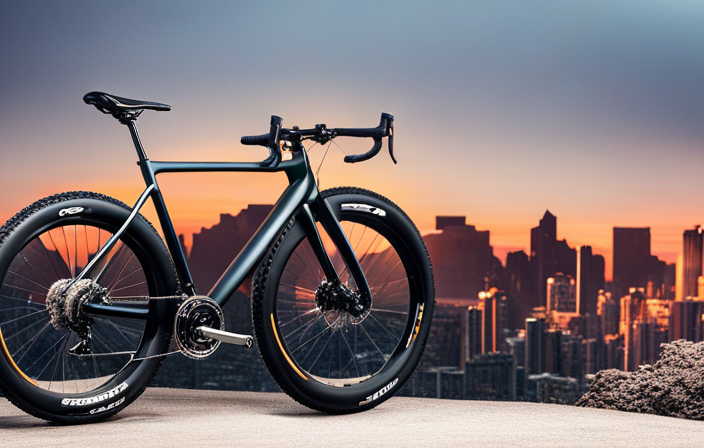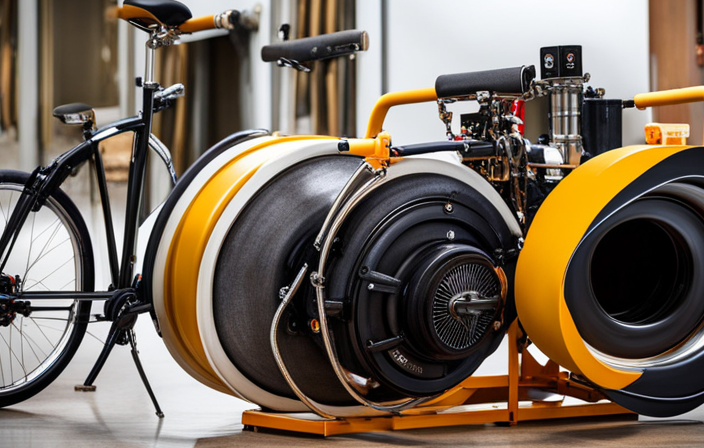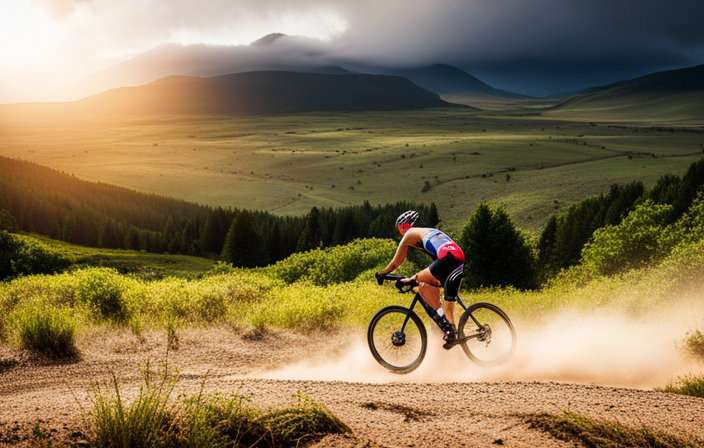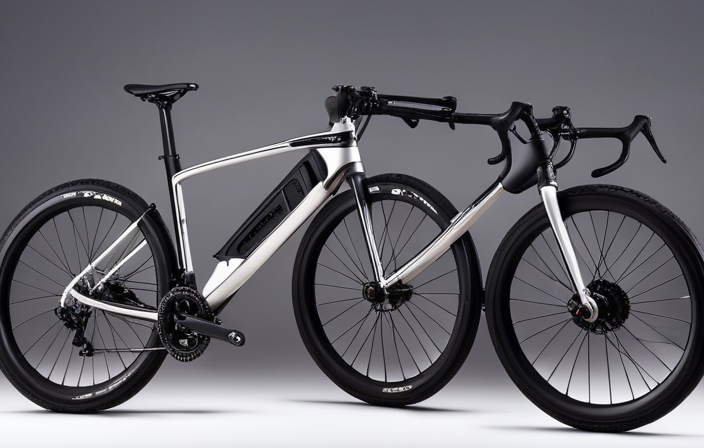You have likely heard about the growing popularity of gravel grinding and are eager to take your road bike off-road. Unsure of where to begin? No need to fret, I have all the information you need.
In this article, I’ll guide you through everything you need to know about turning your trusty road bike into a capable gravel grinder. From assessing compatibility and upgrading tires to adding suspension and fine-tuning your setup, we’ll leave no stone unturned in preparing your bike for the thrilling world of gravel riding.
Let’s dive in!
Key Takeaways
- Upgrading tires to wider options with aggressive tread patterns improves the bike’s performance on gravel and provides better grip.
- Adjusting gearing by upgrading to a wider range cassette and choosing smaller chainrings for easier climbing or larger chainrings for higher speeds on flat sections optimizes the bike’s performance for gravel grinding.
- Installing disc brakes provides improved stopping power and control off-road, while adding suspension absorbs shocks and vibrations for a smoother ride and better traction on challenging terrain.
- Upgrading handlebars for a more upright riding position, adding extra frame protection to minimize damage, enhancing visibility with lights, and carrying essential tools such as a multi-tool, spare tubes, and a mini pump are important for safety and convenience on gravel roads.
Assess Your Bike’s Compatibility
Assess if your bike is compatible for gravel grinding. Before you embark on the journey of turning your road bike into a gravel grinder, it’s crucial to evaluate your bike’s components and performance.
Gravel grinding requires a sturdy and reliable bike that can handle rough terrains and unpredictable conditions.
Start by inspecting the frame of your road bike. Look for signs of damage or weakness, as gravel riding can put additional stress on the frame. Consider if your current frame has clearance for wider tires, which are essential for navigating gravel roads.
Next, assess your bike’s drivetrain and brakes. Gravel rides often involve steep climbs and descents, so make sure your gears are suitable for tackling different gradients. Check if your brakes have enough power to handle off-road conditions effectively.
Evaluate the wheels and tires of your road bike as well. Upgrading to stronger wheels with wider rims can provide better stability and durability on gravel surfaces. Additionally, opt for tubeless-ready tires that offer improved puncture resistance.
By assessing these key components of your bike, you’ll be able to determine its compatibility for gravel grinding. Once you’ve identified any areas that may need improvement or upgrading, you can move on to the next step: upgrading your tires.
Upgrade Your Tires
To enhance your ride on different terrains, consider swapping out the tires on your road bike for more rugged options. Upgrading tire size is one way to improve your bike’s performance on gravel. Look for wider tires, around 32-40mm in width, as they provide better stability and traction on uneven surfaces. The larger volume of air in these tires also helps absorb shocks and vibrations, making for a smoother ride.
Choosing the right tread pattern is equally important when upgrading your tires. For gravel riding, opt for tires with a more aggressive tread design. Look for knobs or lugs that can grip loose gravel and provide better control while cornering. Additionally, consider selecting tubeless-ready tires as they offer lower tire pressure options without risking flats.
Upgrading your tires can significantly transform your road bike into a capable gravel grinder. However, it’s essential to remember that adjusting your gearing is another crucial step towards optimizing your bike’s performance off-road. By addressing both tire selection and gearing adjustments, you’ll be well-equipped to tackle any gravel adventure that comes your way.
Adjust Your Gearing
Consider adjusting the gearing on your road bike to optimize its performance for off-road riding. By adjusting the shifting and upgrading the chainrings, you can ensure that your bike is capable of tackling gravel roads with ease.
When it comes to adjusting your gearing, there are a few key factors to consider. First, you’ll want to evaluate the range of gears available on your current setup. If you find that you frequently run out of gears on steep climbs or struggle to maintain speed on descents, it may be worth upgrading to a wider range cassette. This will give you more options when it comes to selecting the appropriate gear for any given terrain.
Next, take a look at your chainrings. Upgrading to smaller chainrings can make climbing easier by providing lower gearing ratios. On the other hand, larger chainrings can help you achieve higher speeds on flat sections or descents.
By adjusting your shifting and upgrading your chainrings, you can fine-tune your bike’s performance for gravel grinding adventures. The next step in transforming your road bike into a gravel grinder is installing disc brakes, which will provide improved stopping power and control in off-road conditions.
Install Disc Brakes
When installing disc brakes on your road bike, you’ll experience improved stopping power and control while riding off-road. Before diving into the installation process, it’s important to assess the compatibility of your road bike with disc brakes. Some older models may require specific adapters or modifications to accommodate disc brakes. Once you’ve confirmed compatibility, you can proceed with the upgrade.
To install disc brakes, start by removing the existing rim brakes and brake levers from your bike. Next, attach the disc brake calipers to the frame and fork using the provided mounting bolts. Make sure they are aligned properly for optimal performance. Then, connect the hydraulic or mechanical brake lines to each caliper and secure them tightly.
Upgrading pedals is another essential step when converting a road bike into a gravel grinder. Flat pedals with good traction are ideal for off-road riding as they allow for quick foot adjustments and easy dismounting if needed.
Now that you have installed disc brakes and upgraded your pedals, you’re one step closer to transforming your road bike into a capable gravel grinder. The next section will cover how to add suspension for a smoother ride on rough terrains without compromising speed on smooth roads.
Add Suspension
Adding suspension to your road bike can greatly improve the comfort and performance of your ride on rough terrains. The benefits of suspension are numerous, as it helps absorb shocks and vibrations, allowing for a smoother ride. This is especially important when riding on gravel roads or uneven surfaces, where bumps and obstacles can make the ride uncomfortable and even dangerous. Suspension also provides better traction and control, enabling you to navigate through challenging terrain with ease.
When choosing the right suspension for your road bike turned gravel grinder, there are a few factors to consider. First, determine the type of suspension system you want: either a front fork suspension or a full-suspension setup. Front fork suspensions are more common and suitable for most gravel riding situations. However, if you plan on tackling more technical trails or off-road adventures, a full-suspension setup may be worth considering.
Incorporating suspension into your road bike will enhance its capability to handle different terrains with greater ease and comfort. Now that we have covered adding suspension, let’s move on to upgrading your handlebars without compromising your biking experience.
Upgrade Your Handlebars
To enhance your biking experience, why not upgrade your handlebars? Upgrading your handlebars can greatly improve comfort and control while riding on gravel. Here are three ways you can upgrade your handlebars to make them more suitable for gravel grinding:
-
Upgrade Your Stem: Consider replacing your current stem with a shorter and higher-rise stem. This will help you achieve a more upright riding position, reducing strain on your back and neck during long rides. A shorter stem also improves maneuverability, making it easier to navigate rough terrain.
-
Change Your Handlebar Tape: Invest in thicker and more cushioned handlebar tape. This will provide extra padding and absorb vibrations, reducing hand fatigue on bumpy gravel roads. Look for tape that has an anti-slip feature to ensure a secure grip even in wet conditions.
-
Install Wide Fenders: While not directly related to upgrading the handlebars themselves, installing wide fenders can greatly enhance your gravel grinding experience by keeping mud and debris off you and your bike. This will help keep you cleaner and protect important components from damage caused by dirt accumulation.
By upgrading your stem, changing your handlebar tape, and installing wide fenders, you’ll be well-equipped for tackling challenging gravel terrains with ease.
Next up, let’s talk about how to install wide fenders without any hassle!
Install Wide Fenders
Upgrading your handlebars is a great way to improve the comfort and control of your road bike when turning it into a gravel grinder. But that’s not all you need to consider. To fully prepare your bike for off-road adventures, it’s important to install wide fenders.
Wide fenders serve multiple purposes on a gravel bike. Firstly, they help keep you and your bike clean by blocking mud, dirt, and water from splashing onto you while riding through wet or muddy terrain. This means less time spent cleaning your bike after each ride! Secondly, wide fenders increase tire clearance, allowing you to fit larger tires on your road bike.
By increasing tire clearance, wider fenders enable you to upgrade the brakes on your road bike as well. Gravel riding often requires more stopping power due to rougher terrain and varying weather conditions. Upgrading your brakes can give you better control and confidence when navigating challenging surfaces.
Now that we have covered upgrading handlebars and installing wide fenders, the next step in transforming your road bike into a gravel grinder is investing in a reliable gravel-specific saddle…
Invest in a Reliable Gravel-specific Saddle
When it comes to turning a road bike into a gravel grinder, one key consideration is investing in a reliable gravel-specific saddle. It’s important to prioritize comfort and support, especially for long rides on rough terrain.
To find the right saddle, I recommend testing out different options before making a purchase, as what works for one person may not work for another.
Consider the Importance of Comfort and Support
Considering comfort and support is crucial when turning a road bike into a gravel grinder. When venturing off-road, it’s important to find the right balance between comfort and performance. A comfortable bike will allow you to ride longer without experiencing discomfort or fatigue, while still maintaining the necessary efficiency for gravel riding.
To achieve this, focus on finding the right bike fit that suits your body type and riding style. Ensure that your bike’s frame geometry is suitable for off-road riding, providing stability and control over rough terrain. Additionally, consider investing in components like wider tires and suspension systems that absorb vibrations and bumps. These will enhance your overall comfort while allowing you to tackle challenging gravel routes with ease.
When choosing a saddle suitable for long rides on rough terrain, it’s essential to prioritize both comfort and support.
Choose a Saddle Suitable for Long Rides on Rough Terrain
Finding a saddle that provides both comfort and support is essential for long rides on rough terrain. When it comes to choosing a saddle suitable for gravel grinding, there are a few important factors to consider.
First, pay attention to the material of the saddle. Look for options made from durable and lightweight materials such as carbon fiber or titanium, as they can withstand the rigors of off-road riding while keeping weight down.
Additionally, consider the design of the saddle. Look for saddles with ample padding and ergonomic shapes that can provide cushioning and proper support to prevent discomfort during long rides. It’s also worth considering saddles with cutouts or channels in the middle to relieve pressure on sensitive areas.
Ultimately, testing different saddle options before making a purchase will help you find the perfect fit for your gravel grinding adventures without compromising comfort or support.
Test Different Saddle Options Before Making a Purchase
To find the perfect saddle for your long rides on rough terrain, you should test different options before making a purchase. It’s essential to consider various factors when choosing a saddle that will provide optimal comfort and support during your gravel grinding adventures.
One important factor to consider is the width of the saddle, as it should match the distance between your sit bones for proper weight distribution. Additionally, the shape of the saddle plays a crucial role in ensuring a comfortable fit, with options ranging from narrow and sleek designs to wider and more cushioned ones.
Another aspect to evaluate is the material used in construction; leather saddles may offer durability but require more maintenance compared to synthetic materials. By testing different saddle options, you can determine which one suits your riding style and body type best.
The next section will cover how upgrading your pedals can enhance your gravel grinding experience seamlessly.
Upgrade Your Pedals
Upgrading your pedals is essential to turning a road bike into a gravel grinder. When riding on rough and uneven surfaces, having the right pedals can greatly improve your performance and comfort. Here are some key considerations when upgrading your pedals:
-
Upgrade your shoes: Investing in a good pair of cycling shoes specifically designed for gravel riding is crucial. These shoes provide better grip and stability, allowing you to transfer power efficiently to the pedals.
-
Consider clipless pedals: Clipless pedals offer many advantages for gravel grinding. They provide a secure connection between your shoes and the pedals, preventing slippage on bumpy terrain. Additionally, they allow you to use more muscles during each pedal stroke, resulting in improved efficiency.
-
Opt for wider platform pedals: Wide platform pedals offer increased stability and support when navigating through gravelly roads. They provide a larger contact area for your feet, reducing foot fatigue during long rides.
-
Choose durable materials: Look for pedals made from sturdy materials like aluminum or titanium. These materials ensure longevity and can withstand the harsh conditions encountered while riding off-road.
By upgrading your pedals and considering these factors, you’ll enhance both the performance and durability of your road bike as it transitions into a capable gravel grinder.
To further protect your bike’s frame from potential damage caused by debris or impacts, adding extra frame protection is highly recommended.
Add Extra Frame Protection
Now that we have upgraded our pedals, let’s move on to adding some extra frame protection to our road bike turned gravel grinder. When riding off-road, your bike is more prone to scratches and dings from rocks, branches, and other obstacles. By adding frame protection, you can minimize the damage and keep your bike looking pristine.
There are several options for frame protection, such as adhesive vinyl wraps or clear protectors that can be applied directly onto the vulnerable areas of your bike. These protective layers act as a shield against potential scrapes and scratches, ensuring that your precious bike remains in top condition.
In addition to frame protection, it’s also crucial to consider tire upgrades for optimal performance on gravel terrain. Gravel-specific tires typically feature wider treads with increased traction and puncture resistance. This allows for better grip and stability when navigating rough surfaces.
By equipping your road bike with frame protection and upgrading your tires, you’ll be well-prepared for the challenges of gravel riding. But before we hit the trails, there’s one more essential upgrade we need: lights to ensure visibility in low-light conditions.
Equip Your Bike with Lights
When riding on gravel roads, visibility is of utmost importance for safety. To ensure that I’m visible to other road users, I choose bright and reliable front and rear lights for my bike. These lights not only illuminate the path ahead but also make me more conspicuous in low-light conditions.
Additionally, considering additional lighting options such as helmet-mounted or wheel-mounted lights can further enhance safety. These lights provide a wider field of vision and make me even more visible from different angles.
Importance of Visibility on Gravel Roads
Visibility on gravel roads is crucial when converting a road bike into a gravel grinder. To ensure your safety and maintain control, it’s essential to prioritize visibility in various ways. Here are four key elements that can greatly enhance your visibility:
-
Reflective clothing: Wearing high-visibility clothing allows you to stand out in low-light conditions, making it easier for motorists and other cyclists to spot you from a distance.
-
Rearview mirror: Installing a rearview mirror on your handlebars provides valuable situational awareness by allowing you to monitor traffic behind you without turning your head, reducing the risk of accidents.
-
Bright front and rear lights: Choose lights with high lumens output and multiple modes to increase your visibility both during the day and at night.
-
Reliable light mounts: Ensure your lights are securely attached to your bike using reliable mounts that can withstand the vibrations of rough gravel roads.
By incorporating these measures, you significantly improve your safety on gravel roads. This sets the stage for the subsequent section about choosing bright and reliable front and rear lights.
Choose Bright and Reliable Front and Rear Lights
To ensure optimum safety, it’s important to select bright and dependable front and rear lights for your gravel riding experience.
When it comes to front light options, there are a few key factors to consider. Look for lights that offer a high lumen output to provide maximum visibility in low-light conditions. Additionally, choose a light with different brightness settings so you can adjust the intensity based on the surrounding environment.
For rear light options, opt for lights that have a wide-angle beam pattern to increase your visibility from all angles. It’s also crucial to choose lights that have long battery life or are rechargeable so you don’t run out of power during your ride.
By selecting the right front and rear lights, you can greatly enhance your visibility on gravel roads and ensure a safer riding experience.
Consider additional lighting options for enhanced safety without needing an extra step in your setup.
Consider Additional Lighting Options for Enhanced Safety
For an extra layer of safety, you might want to consider adding additional lighting options to your setup. When it comes to riding in low-light conditions or on dark trails, visibility is crucial.
Here are some additional lighting options that can enhance your safety:
-
Bike-mounted headlights: These powerful lights provide a clear view of the road ahead and make you more visible to others.
-
Helmet-mounted lights: Attach these lightweight lights to your helmet for increased visibility wherever you look.
-
Wheel or frame lights: These colorful LED lights not only make you more visible but also add a fun touch to your bike.
-
Reflective gear: Invest in reflective vests, jackets, or ankle bands that reflect light and make you stand out even in the darkest conditions.
-
Light-up gloves or shoe clips: These accessories with built-in LED lights improve your visibility from all angles.
By incorporating these additional lighting options, you’ll significantly improve your visibility and ensure a safer ride.
Now, let’s move on to the next section about carrying essential tools and accessories for gravel grinding.
Carry Essential Tools and Accessories
Don’t forget to carry all the essential tools and accessories you need when turning your road bike into a gravel grinder. Bike maintenance becomes even more important when venturing into off-road terrains, so it’s crucial to be prepared.
One of the first things you should have is a multi-tool that includes different sizes of Allen wrenches, screwdrivers, and a chain breaker. This will allow you to make on-the-go adjustments and repairs as needed. Additionally, carrying spare tubes, tire levers, and a mini pump or CO2 inflator is essential in case of punctures or sudden loss of pressure.
Gravel riding tips also include having a patch kit for quick fixes on the trail and a small first aid kit for any minor injuries that may occur. It’s wise to pack some zip ties and duct tape as well; they can come in handy for makeshift solutions if something breaks or needs securing temporarily.
By being equipped with these tools and accessories, you’ll be better prepared to handle any unexpected situations that may arise during your gravel adventures.
Now that we have covered the importance of carrying essential items, let’s move on to fine-tuning your bike’s suspension and tire pressure for optimal performance on varied terrain without compromising comfort.
Fine-tune Your Bike’s Suspension and Tire Pressure
Adjusting your bike’s suspension and tire pressure can greatly enhance its performance on various terrains. When it comes to gravel grinding, fine-tuning your bike’s suspension is essential for a smooth and controlled ride. Suspension adjustments allow you to optimize the amount of travel and damping, ensuring that your bike absorbs bumps effectively without feeling too soft or stiff.
Start by adjusting the sag, which is the amount your suspension compresses under your weight when you’re sitting on the bike. This will help you find the right balance between comfort and efficiency. Additionally, consider adjusting the rebound damping to control how quickly your suspension returns after compression.
In addition to suspension adjustments, adjusting tire pressure is crucial for optimal gravel riding performance. Lowering tire pressure provides better traction and allows your tires to conform to uneven surfaces, reducing vibrations and improving overall stability. However, keep in mind that too low of a tire pressure can increase rolling resistance and risk pinch flats. Experiment with different pressures based on your weight, terrain conditions, and personal preferences.
By fine-tuning your bike’s suspension and adjusting tire pressure accordingly, you’ll have a smoother ride with improved control on gravel roads. Practice and familiarize yourself with gravel riding techniques will further enhance your skills in tackling this challenging terrain seamlessly.
Practice and Familiarize Yourself with Gravel Riding Techniques
To enhance your skills in tackling challenging gravel terrain, it’s important to practice and become familiar with various gravel riding techniques. Here are some key gravel bike skills to master:
-
Body Positioning: Maintain a centered and balanced position on the bike, shifting your weight as needed to maintain control and stability.
-
Cornering: Learn how to navigate turns on loose surfaces by leaning the bike into the turn while keeping your body upright.
-
Climbing and Descending: Adjust your gear selection and body position for efficient climbing, while using controlled braking techniques when descending steep sections.
-
Handling Rough Terrain: Develop the ability to absorb bumps and obstacles by bending your arms and legs, allowing the bike to move beneath you.
-
Choosing the Right Gravel Routes: Research and select routes that match your skill level. Start with easier terrains before gradually progressing to more technical challenges.
By practicing these techniques regularly, you’ll build confidence in handling different types of gravel surfaces.
As you hone your skills, don’t forget to enjoy the adventure and explore new gravel routes that will further push your abilities without compromising safety or fun.
Enjoy the Adventure and Explore New Gravel Routes
Explore new gravel routes and embrace the adventure of discovering unfamiliar terrain. Riding a road bike on gravel can be a thrilling experience that allows you to enjoy the benefits of both road cycling and off-road biking. Gravel riding offers numerous benefits, including improved stability, versatility, and increased comfort due to its wider tires and relaxed frame geometry.
To fully enjoy your gravel adventures, it’s important to consider some tips for riding at night. Firstly, invest in high-quality lights both on the front and rear of your bike to ensure visibility. Additionally, wearing reflective clothing will make you more visible to other road users. It is also crucial to plan your route beforehand, especially when exploring unfamiliar areas, as this will help you avoid potential hazards.
To further enhance your knowledge about gravel riding and night cycling safety, refer to the following table:
| Gravel Bike Benefits | Tips for Gravel Riding at Night |
|---|---|
| Improved stability | Invest in high-quality lights |
| Versatility | Wear reflective clothing |
| Increased comfort | Plan your route beforehand |
By following these tips and exploring new gravel routes, you can create unforgettable experiences while enjoying the freedom that comes with riding off-road on your converted road bike. So get out there and start exploring!
Frequently Asked Questions
Can I convert any road bike into a gravel grinder?
Yes, you can convert some road bikes into gravel grinders. However, using a mountain bike for gravel grinding is often more suitable due to its wider tires and stronger frame.
As for the best tires for gravel riding, look for ones with a tread pattern designed for off-road use and wider widths to provide better traction and stability on loose surfaces.
What are the benefits of upgrading to disc brakes?
Upgrading to disc brakes on a road bike is like unleashing the power of a rocket ship!
The benefits of hydraulic disc brakes are simply mind-blowing. They provide unmatched stopping power, even in wet and muddy conditions, making your rides safer than ever before.
On the other hand, mechanical disc brakes offer precise control and easy maintenance.
So whether you choose hydraulic or mechanical, upgrading to disc brakes will revolutionize your biking experience.
Get ready for an adrenaline-fueled adventure!
How do I choose the right gravel-specific saddle?
Choosing the right saddle for gravel riding is crucial for optimal comfort during long rides. Start by considering the width and shape of the saddle to match your sit bones. Look for a saddle with added padding or gel inserts to absorb vibrations from rough terrain.
Adjusting the saddle position is also important; ensure it’s level and experiment with different angles until you find the most comfortable position. Remember, finding the right saddle may require some trial and error, so don’t be afraid to test out different options.
Are wider fenders necessary for gravel riding?
Wider fenders can be beneficial for gravel riding. They provide more coverage and protection from mud, dirt, and debris that you may encounter on rough terrain.
Additionally, wider tires are often used in gravel riding to improve stability and traction. When combined with a tubeless setup, they can further enhance your ride by reducing the risk of flats and allowing you to run lower tire pressures for a smoother experience on uneven surfaces.
What are the essential tools and accessories I should carry for gravel riding?
When it comes to gravel riding, there are a few essential tools and accessories that I always make sure to carry.
First and foremost, upgrading tires is crucial for better traction on the rough terrain.
Additionally, having essential clothing like padded shorts, a breathable jersey, and gloves can greatly enhance comfort during long rides.
Other important items include a multi-tool for any necessary repairs, spare tubes, a mini pump or CO2 inflator, and of course, plenty of water and snacks.
Conclusion
So there you have it, folks! With just a few simple upgrades and adjustments, you can turn your regular road bike into a gravel grinding machine.
It may seem like a daunting task at first, but trust me when I say that the end result is well worth the effort. Imagine flying down those gravel paths with ease, tackling rough terrains like a pro, and exploring new routes that were once off-limits.
The possibilities are endless! So go ahead, take on this adventure, and let your road bike transform into the ultimate gravel grinder.
Happy riding!









